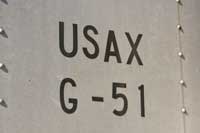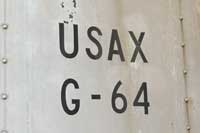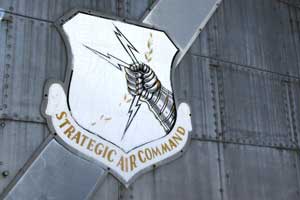Guard cars G-51, G-53, and G-54 were originally built by American Car and Foundry in 1943 as Troop Kitchen Cars. There were 440 of these cars constructed for use on American railroads. The Heart of Dixie Railroad Museum owns four surviving examples of these interesting pieces of railroad equipment. Guard car G-64 was built as a Hospital Kitchen Car in 1944 for the U.S. Army. This car also carried the designation USA 8751 at that time.
The cars were owned by the Defense Plant Corporation and were operated by the Pullman Company for the military in agreement with the railroads upon which they traveled. The cars are 54 feet 2 ½ inches long from coupler to coupler and 9’ 11 ½” wide from side to side, and 13’ 6 ½” high. These cars currently have high speed trucks with Hyatt bearings for use on passenger trains, but were originally built with friction bearings.
 When built these cars had a Vapor steam heating system, and air pressure water system, and battery powered lighting. The original weight was 77,500 lbs. (38.75 tons). As built the cars had a work table, utensil drawers, cupboards, refrigerator, two large sinks, water tanks, two cast iron coal fired Army ranges in tandem, a wood storage bin, and a half ton coal box with rooftop hatch. These areas were in two thirds of the car. In the other third of the car was a shower, toilet, fold up sink, and water tanks. The cars also had a bread locker and meat cutting table.
When built these cars had a Vapor steam heating system, and air pressure water system, and battery powered lighting. The original weight was 77,500 lbs. (38.75 tons). As built the cars had a work table, utensil drawers, cupboards, refrigerator, two large sinks, water tanks, two cast iron coal fired Army ranges in tandem, a wood storage bin, and a half ton coal box with rooftop hatch. These areas were in two thirds of the car. In the other third of the car was a shower, toilet, fold up sink, and water tanks. The cars also had a bread locker and meat cutting table.
The cars were painted the standard military olive drab and were lettered with 5-inch white lettering over the side doors reading UNITED STATES ARMY. There was also lettering in 4-inch white characters over each truck with the individual car numbers. To the right of each side door was the lettering KITCHEN CAR in 4-inch letters and to the left of the side doors was the insignia for the branch of military to which the car was assigned. This was displayed in a 10-inch diameter circle. The end doors also contained the lettering KITCHEN CAR in 1 ¼inch letters as well as the car letters and number in 1 ¼inch letters.
From April through August of 1953, the Army accepted delivery of 89 new dual purpose Troop/ Hospital kitchen cars manufactured by the St. Louis Car Company. This delivery left the Army with no real need to retain the World War II era cars, at least in their present configuration. The Army at the time did however have a need for guard cars to escort classified rail shipments. The excess kitchen cars were suitable in size for this purpose and were therefore, converted in Army facilities. Guard cars carried USAX reporting marks and road numbers with a “G-“ prefix.
 Records indicate that cars G-10 through G-60 were converted in 1964 from Troop Kitchen Cars to guard cars. During 1965 car USA 8751 (G-64) was still listed in the Official Register of Passenger Train Equipment and was reported as the only one of the 1944 built Hospital Kitchen Cars still on the Army roster. Car G-64 was converted in during 1965. At the time of the conversion cars G-51, G-53, and G54 had friction bearings and G-64 had roller bearings, although when the museum received the cars, all cars had roller bearings. It is believed that the trucks were all changed out to roller bearings at some point for consistency and ease of maintenance.
Records indicate that cars G-10 through G-60 were converted in 1964 from Troop Kitchen Cars to guard cars. During 1965 car USA 8751 (G-64) was still listed in the Official Register of Passenger Train Equipment and was reported as the only one of the 1944 built Hospital Kitchen Cars still on the Army roster. Car G-64 was converted in during 1965. At the time of the conversion cars G-51, G-53, and G54 had friction bearings and G-64 had roller bearings, although when the museum received the cars, all cars had roller bearings. It is believed that the trucks were all changed out to roller bearings at some point for consistency and ease of maintenance.
Regardless of the origin of the cars, whether it was a Troop Kitchen car or a Hospital Kitchen car, during the conversion process the interiors of these cars were stripped and subdivided into four functional areas: (1) a crew support area. (2) an open area between the two side doors. (3) a crew restroom and bathing area. (4) a soundproofed utility room containing a Vapor hot water heating system, air conditioning system, generator, and miscellaneous electrical apparatus. Some of the cars converted had four water tanks, others had two water tanks. The water capacities were the same regardless of the number of tanks on the individual car.
 The crew support area was 23’ 10”. This area of the cars originally contained a range, double sink, utensil cabinet, and cook’s work table. When rebuilt as guard cars, the cars contained a stainless steel electric range/oven, a stainless steel single basin sink, a storage cabinet with three drawers, a coffee urn, an electric refrigerator/freezer, a shower/lavatory/toilet area, two fixed dining tables with bench seats, overhead water tanks, one utility locker, one lounge seat, one gun cabinet. Of the 12 windows originally in each car, only the six (three on each side) on the end of the car opposite the utility room were retained. The other six windows were plated over along with the side ventilation openings on the car.
The crew support area was 23’ 10”. This area of the cars originally contained a range, double sink, utensil cabinet, and cook’s work table. When rebuilt as guard cars, the cars contained a stainless steel electric range/oven, a stainless steel single basin sink, a storage cabinet with three drawers, a coffee urn, an electric refrigerator/freezer, a shower/lavatory/toilet area, two fixed dining tables with bench seats, overhead water tanks, one utility locker, one lounge seat, one gun cabinet. Of the 12 windows originally in each car, only the six (three on each side) on the end of the car opposite the utility room were retained. The other six windows were plated over along with the side ventilation openings on the car.
The crew support area was 23’ 10”. This area of the cars originally contained a range, double sink, utensil cabinet, and cook’s work table. When rebuilt as guard cars, the cars contained a stainless steel electric range/oven, a stainless steel single basin sink, a storage cabinet with three drawers, a coffee urn, an electric refrigerator/freezer, a shower/lavatory/toilet area, two fixed dining tables with bench seats, overhead water tanks, one utility locker, one lounge seat, one gun cabinet. Of the 12 windows originally in each car, only the six (three on each side) on the end of the car opposite the utility room were retained. The other six windows were plated over along with the side ventilation openings on the car.
The crew berthing area was 14’ long and began just beyond the center door corridor and was separated from the kitchen/dining area by a full partition with an accordion type folding door. The berthing area was equipped with three Glennan triple tier adjustable berth units and one large sliding door locker for clothing and personal effects. One 110 volt reading light was provided for each berth. Beyond the crew berthing area was the generator room (approximately 9’ 6” long). It was separated from the crew berthing area by a soundproof wall with a center aisle doorway fitted with double sound reducing doors.
 The generator room housed a diesel engine driving a 21.5 KW generator, air conditioning equipment, an oil fired Vapor Aquazone unit (water and heating), the electrical controls, a twelve volt batter, and temperature controls for the car. The exterior walls of the generator room were equipped with air intake louvers for the diesel engine, heating unit, and air conditioning unit. The diesel engine and Aquazone unit were vented through the roof. Both the diesel engine and the Aquazone unit were fueled from the tank or tanks beneath the car. The diesel naturally using diesel fuel and the Aquazone heating unit using fuel oil. (Later the Aquazone units were converted to operate using propane.).
The generator room housed a diesel engine driving a 21.5 KW generator, air conditioning equipment, an oil fired Vapor Aquazone unit (water and heating), the electrical controls, a twelve volt batter, and temperature controls for the car. The exterior walls of the generator room were equipped with air intake louvers for the diesel engine, heating unit, and air conditioning unit. The diesel engine and Aquazone unit were vented through the roof. Both the diesel engine and the Aquazone unit were fueled from the tank or tanks beneath the car. The diesel naturally using diesel fuel and the Aquazone heating unit using fuel oil. (Later the Aquazone units were converted to operate using propane.).
In addition to the on board diesel generator set, the cars were equipped for both 115 volt single phase and 208 volt three phase wayside power. An internal selection switch was used to select the appropriate receptacle.
The space heating was provided by a closed loop system of overhead and baseboard fin radiator elements through which a freeze protected 50% ethylene glycol and 50% water solution was circulated by two electric pumps. The radiator elements were independently controllable, providing flexibility in heating. Some cars such as G51-G54 were also equipped later with supplemental electric heating units spaced throughout the car.
Air conditioning was provided by a three phase 208 volt 5 ton unit. This unit circulated 1,500 cubic feet per minute of air through a re-circulating duct system. The Aquazone unit, manufactured by the Vapor Corporation, incorporated hat exchangers which permitted both wash water and the space heating system to be heated by a train line system or by the Aquazone oil burner. Temperature was automatically controlled by three adjustable mercury thermostats, one controlling heating and two controlling cooling.
Four centerline fluorescent ceiling fixtures provided area illumination in the generator room, berth room, and lounge area. The kitchen and dining area were lighted with incandescent fixtures. Emergency lighting was provided in each compartment.
Of note, Cars numbered G-13 through G-18 and G-64 had one type refrigerator, range, water pump, faucets and brake system while cars G-50 through G-63 had a different type of equipment. The differences usually being just that of the brand of appliances used.
These cars were eventually assigned to Hill Air Force Base in Utah where they were used as companion/crew cars for military flight simulator cars converted from Pullman sleeping cars. The flight simulator cars contained KC-135A Flight Simulators.
Each former guard car had a specific assigned mate/simulator car that it was paired with at all times. The only major modification to the cars for this service was the removal of some of the berths, which were replaced with a work bench, under counter cabinets and drawers, and upper cabinets. These cabinets and work surfaces were used to store any and all spare parts for the guard car and its associated flight simulator car. Enough spare parts were carried to effectively repair any broken or faulty part while in transit or stationary at various military facilities while the simulator cars were being used.
Another notable change to the cars was the ability for the guard car to supply three phase power to the flight simulator car via under car cable and receptacles on the ends of both cars.
 Cars G-51, G-53, G-54 and G-64 were declared surplus in August of 1988. These cars were purchased as surplus from the United States Government by The Heart of Dixie Railroad Museum in the early 1990’s. The cars were received in basically the escort/support car arrangement when the museum bought the cars. When the museum bought the cars they were stored on an Air Force base in Utah and required only minor checking and certifying before the cars could be shipped on their own wheels.
Cars G-51, G-53, G-54 and G-64 were declared surplus in August of 1988. These cars were purchased as surplus from the United States Government by The Heart of Dixie Railroad Museum in the early 1990’s. The cars were received in basically the escort/support car arrangement when the museum bought the cars. When the museum bought the cars they were stored on an Air Force base in Utah and required only minor checking and certifying before the cars could be shipped on their own wheels.
 Car G-51 is being modernized for use as the passenger car shop office, sign shop area, and upholstery area. The car is currently parked on a siding next to the shop building. Car G-54 was gutted and converted to a head end power car by the Museum and currently is in regular service as HEP-54. Car G-64 is being used as supplemental storage for the museum library and is sitting on a panel track next to the Woodlawn Depot/Library. Car G-53 is not currently being used and is sitting on a panel track awaiting a decision on its future use.
Car G-51 is being modernized for use as the passenger car shop office, sign shop area, and upholstery area. The car is currently parked on a siding next to the shop building. Car G-54 was gutted and converted to a head end power car by the Museum and currently is in regular service as HEP-54. Car G-64 is being used as supplemental storage for the museum library and is sitting on a panel track next to the Woodlawn Depot/Library. Car G-53 is not currently being used and is sitting on a panel track awaiting a decision on its future use.


